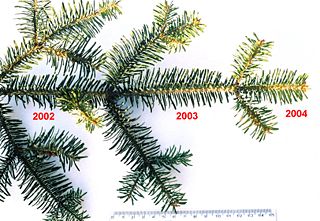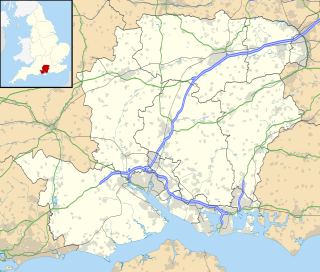
Buddleja davidii, also called summer lilac, butterfly-bush, or orange eye, is a species of flowering plant in the family Scrophulariaceae, native to Sichuan and Hubei provinces in central China, and also Japan. It is widely used as an ornamental plant, and many named varieties are in cultivation. B. davidii is named after the French missionary and explorer in China, Father Armand David, who was the first European to report the shrub. It was found near Ichang by Dr Augustine Henry about 1887 and sent to St Petersburg. Another botanist-missionary in China, Jean-André Soulié, sent seed to the French nursery Vilmorin, and B. davidii entered commerce in the 1890s.
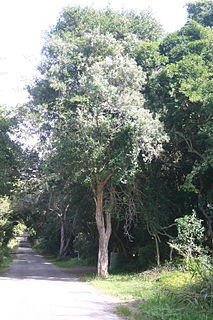
Buddleja saligna, the false, or bastard, olive, is almost endemic to South Africa where it has a wide distribution. It occurs most often in ravines and against outcrops, and is distributed from coastal elevations to the central plateau at elevations of < 2000 m. The species was first described and named by Willdenow in 1809.
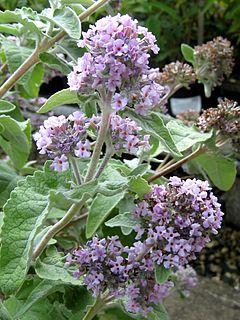
Buddleja crispa, sometimes called the Himalayan butterfly bush, is native to Afghanistan, Bhutan, North India, Nepal, Pakistan and China, where it grows on dry river beds, slopes with boulders, exposed cliffs, and in thickets, at elevations of 1400–4300 m. Named by Bentham in 1835, B. crispa was introduced to cultivation in 1850, and came to be considered one of the more attractive species within the genus; it ranked 8th out of 57 species and cultivars in a public poll organized by the Center for Applied Nursery Research (CANR) at the University of Georgia, USA.. In the UK, B. crispa was accorded the Royal Horticultural Society's Award of Merit in 1961. However, the species is not entirely cold-hardy, and thus its popularity is not as ubiquitous as it might otherwise be.
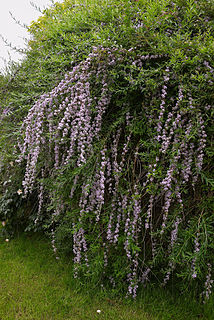
Buddleja alternifolia, known as alternate-leaved butterfly-bush, is a species of flowering plant endemic to Kansu, China, where it grows along river banks in thickets at elevations of 1,500 – 4,000 m. A substantial deciduous shrub growing to 4 metres (13 ft) tall and wide, it bears grey-green leaves and graceful pendent racemes of scented lilac flowers in summer.

Buddleja fallowiana is a species of flowering plant endemic to the Yunnan province of western China, where it grows in open woodland, along forest edges and watercourses. The plant was collected in China by Forrest in 1906, and named in 1917 by Balfour & Smith for George Fallow, a gardener at the Royal Botanic Garden Edinburgh who had died in Egypt in 1915 from wounds sustained fighting in the Gallipoli Campaign.

Buddleja glomerata is a shrub endemic to the mountains of the Karoo desert in South Africa, where it grows among boulders on dry hillsides. The species was first described and named by Heinrich Wendland in 1825. The shrub has a number of common names locally, the most popular being 'Karoo Sagewood'.
Buddleja polystachya is a multi-branched shrub or occasionally small tree endemic to the semi-arid highlands flanking the Red Sea in Eritrea, Ethiopia, Saudi Arabia, Somalia and Yemen, where it grows in secondary scrub or around forest, often along watercourses, at elevations of between 2,200 and 3,600 m ; its range extends southward into the highlands of Kenya and Tanzania. The species was named by Georg Fresenius in the early part of the 19th century.

Buddleja asiatica is a somewhat tender deciduous shrub native to a vast area of the East Indies, including India, Nepal, Bangladesh, China, Taiwan, Burma, Thailand, Laos, Cambodia, Vietnam, Malaysia, New Guinea, and the Philippines, growing in open woodland at elevations < 2,800 m either as understorey scrub, or as a small tree. First described by Loureiro in 1790, B. asiatica was introduced to the UK in 1874, and accorded the RHS Award of Garden Merit in 1993. It is highly invasive in Hawaii, Guam, and the Northern Mariana Islands.

Buddleja cordata is endemic to Mexico, growing along forest edges and water courses at elevations of 1500–3000 m; it has also naturalized in parts of Ethiopia. The species was first described and named by Kunth in 1818.
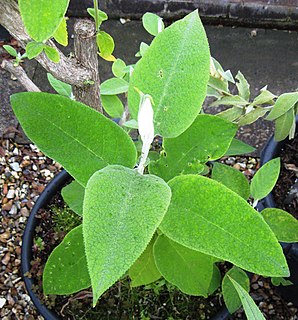
Buddleja crotonoides is a shrub with a wide distribution, from California south to Nicaragua. The shrub grows at elevations of 2,000–2,500 m in oak woods and on scree in association with Arbutus xalapiensis, Pinus sp., and Crataegus mexicana. B. crotonoides was first named and described by Gray in 1847.
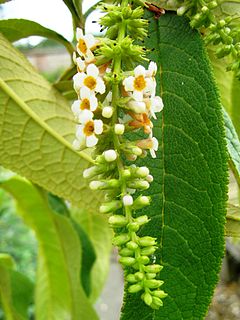
Buddleja forrestii is a deciduous shrub or small tree widely distributed from India to western China. First described by Diels in 1912, he named the species for plant hunter George Forrest, who discovered the plant in Yunnan in 1904 and introduced it to Western cultivation.

Buddleja japonica is a deciduous shrub native to Honshu and Shikoku, Japan, where it grows on mountain slopes amid scrub. The shrub was named and described by Hemsley in 1889, and introduced to Western cultivation in 1896.

Buddleja madagascariensis, also known as smokebush, is an evergreen shrub endemic to Madagascar, where it grows amongst scrub on mountain slopes to elevations of 600–2,000 metres (2,000–6,600 ft). The species was first named and described by Lamarck in 1792, and introduced to cultivation in 1827. It was listed by Masters in his Hortus duroverni Canterbury nursery catalogue of 1831. Popular around the world as an ornamental, B. madagascariensis has widely naturalized and is now classified as an invasive species in Hawaii; it can also be found growing wild in southern China, and along the Mediterranean coast of France.
Buddleja curviflora is a deciduous shrub native to southern Japan and Taiwan, where it grows in thickets on stony slopes at elevations of 100–300 m. B. curviflora was named and described Hooker & Arnott in 1838. Plants in Taiwan have been described as a separate species Buddleja formosana and assessed as Critically Endangered by IUCN, but the distinction is not recognized by Li and Leeuwenberg, who sank formosana as a synonym.
Buddleja axillaris is a shrub endemic to Madagascar, the Comoro Islands, and Tanzania, growing in forests at elevations of 300–1400 m. The species was first named and described by Willdenow in 1827
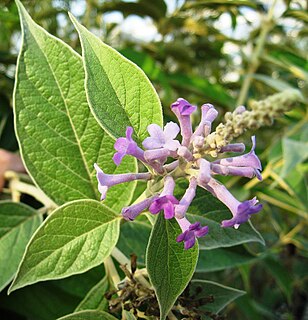
Buddleja myriantha is a species endemic to upper Burma and western China, including Tibet, where it grows along forest edges, thickets and streams at altitudes of 2,000 – 3,200 m. The species was first described and named by Diels in 1912.

Buddleja fallowianavar.albaSabourin is a white-flowered variety of B. fallowiana endemic to Yunnan in western China, where it grows in open woodland, along forest edges and watercourses. The shrub was considered superior to the lavender-blue flowered B. fallowiana by Bean, who thought it one of the most attractive of all Buddlejas.

Buddleja 'Burncross' is a British hybrid cultivar discovered by Dr Robert Senior at Penzance in 2000 and raised at Moor House in North Yorkshire. Sterile and thus non-invasive, 'Burncross' was patented and introduced to commerce in 2012.
Buddleja candida is a small deciduous shrub widely distributed from north-east India through south east Xizang (Tibet) to the provinces of Sichuan and Yunnan in western China, growing on forest edges, in mountain thickets, and along riverbanks, at altitudes of 1000 – 2500 m. Named and described by Dunn in 1920, the shrub was introduced to cultivation in the west in 1928.
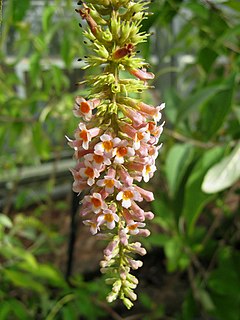
Buddleja macrostachya is a large deciduous shrub or small tree with a vast distribution, from Xizang (Tibet) through western China, Bhutan, Sikkim, northern India, Bangladesh, Myanmar (Burma), to Thailand and Vietnam, growing in scrub on mountain slopes to an altitude of 3,200 m, and along rivers in forests. The species was named and described by Wallich ex Bentham in 1835.

